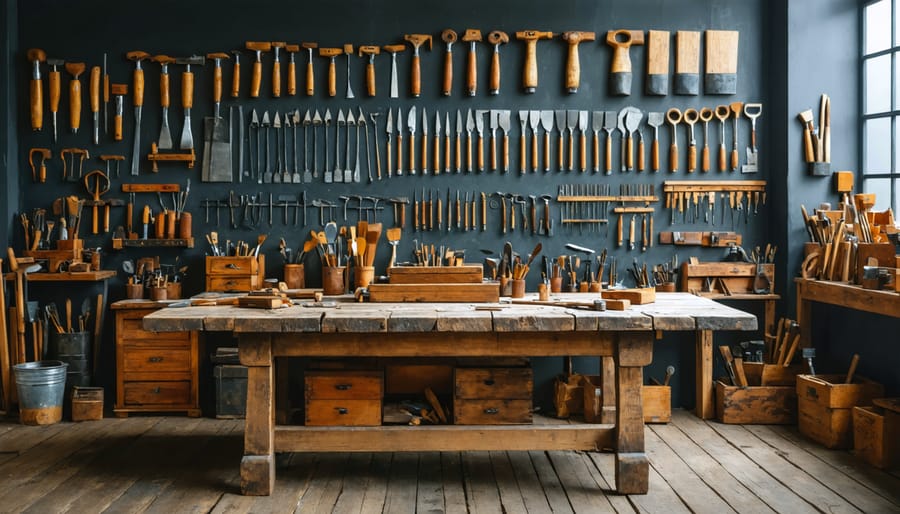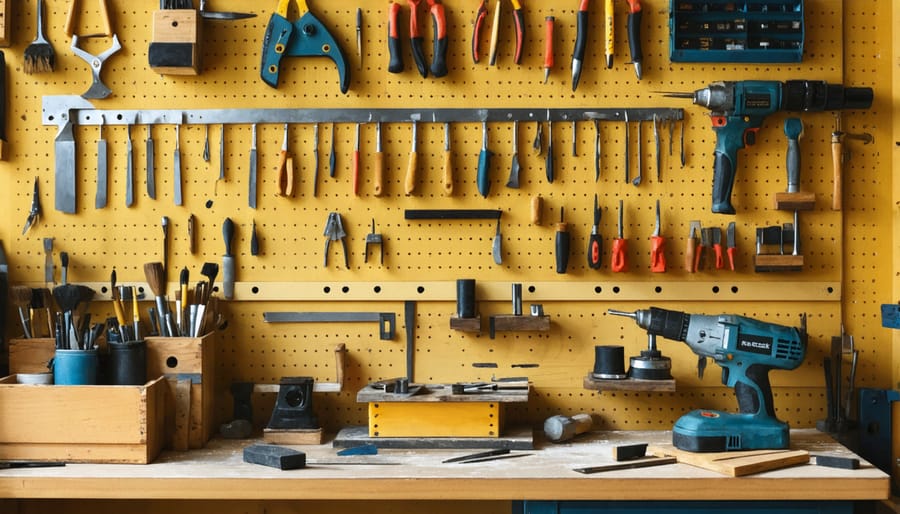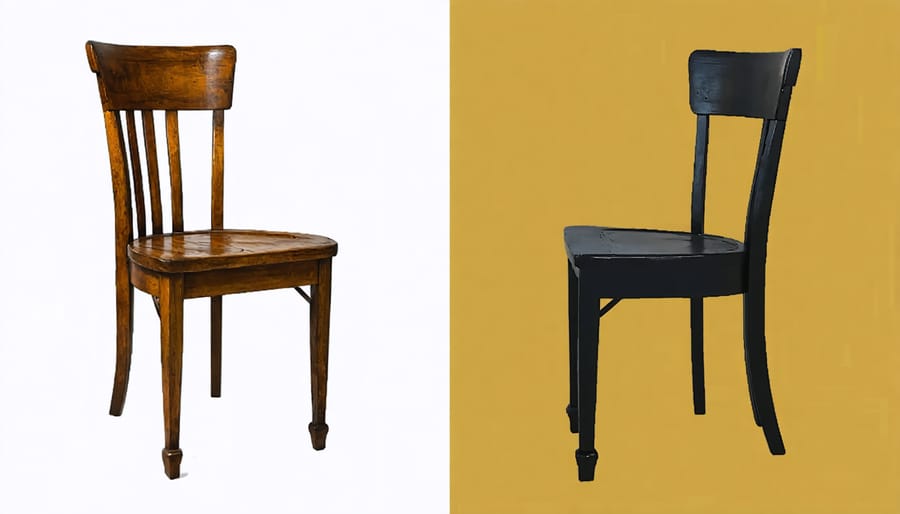
Transform cherished heirlooms and neglected treasures into stunning showpieces through professional furniture restoration training. Master artisans guide students through centuries-old techniques merged with modern conservation methods in hands-on workshops designed for both beginners and experienced craftspeople. From antique wood repair and traditional upholstery to specialty finishing techniques, these comprehensive classes equip participants with marketable skills valued by high-end restoration firms, museums, and private collectors.
Students progress from basic wood identification and period-appropriate repair methods to advanced skills like French polishing, marquetry, and decorative veneer work. Each class combines theoretical knowledge with extensive practical application, ensuring graduates can confidently tackle complex restoration projects. Working in fully-equipped workshops with period-specific tools and materials, participants develop the refined craftsmanship and problem-solving abilities essential for professional success in furniture conservation.
Beyond technical expertise, these courses cultivate an deep appreciation for historical furniture styles, construction methods, and the delicate balance between preservation and restoration. Whether pursuing a career change or enhancing existing skills, furniture restoration classes open doors to a rewarding profession where artistry meets craftsmanship.
In our furniture restoration classes, students gain hands-on experience with a comprehensive array of professional restoration tools and materials. You’ll learn to work with precision hand tools including various chisels, scrapers, and specialty sanders that help preserve the integrity of antique pieces. Our well-equipped workshops feature industrial-grade equipment such as moisture meters, wood lathes, and spray finishing systems.
Students become proficient in selecting and using different adhesives, from traditional hide glue to modern epoxies, understanding when each type is most appropriate. The course covers essential finishing materials including shellac, various varnishes, and specialty waxes, along with the proper application techniques for each.
Safety equipment is emphasized, with students receiving training in the proper use of respiratory protection, safety glasses, and protective gloves. We also introduce specialized diagnostic tools like black lights for finish identification and magnifying equipment for wood species analysis. Each student receives a detailed guide outlining recommended tools and suppliers, helping them build their professional kit as they progress through the course.

In our comprehensive furniture restoration classes, students learn essential restoration techniques through hands-on practice and expert guidance. The curriculum begins with surface preparation, teaching proper cleaning methods and how to safely remove old finishes without damaging the underlying wood. Students master the art of wood repair, including filling scratches, addressing water damage, and reconstructing damaged areas using period-appropriate materials.
The course covers advanced finishing techniques, from traditional French polishing to modern spray applications. Participants learn color matching and staining processes, ensuring seamless repairs that maintain the piece’s historical integrity. Special attention is given to upholstery basics, including fabric selection, padding replacement, and proper tacking techniques.
Students work with various tools and equipment, from traditional hand planes and chisels to modern power tools. The curriculum emphasizes sustainable restoration practices, teaching students how to preserve original materials whenever possible while ensuring structural integrity.
Each restoration project includes detailed documentation, helping students develop professional assessment and quotation skills. Instructors demonstrate proper handling of different wood species, various finish types, and period-specific construction methods. Safety protocols and workspace organization are integrated throughout the course, ensuring students develop proper habits for their future restoration work.
By the end of the program, participants can confidently approach furniture restoration projects with a comprehensive understanding of both traditional and contemporary methods, preparing them for professional work or advanced hobby pursuits.
During the furniture restoration program, students work on carefully selected projects that progressively build their skills and confidence. Starting with basic techniques, students begin by restoring small wooden boxes or side tables, learning proper surface preparation and finishing methods. As skills develop, they advance to more complex pieces like dining chairs, where they master upholstery removal, frame repair, and reupholstering techniques.
Mid-program projects typically include antique dressers or cabinets, allowing students to practice drawer repair, hardware restoration, and decorative elements preservation. Students learn to address common issues like water damage, wood rot, and veneer replacement through hands-on experience with these pieces.
Advanced projects challenge students with valuable period pieces, such as Victorian-era armchairs or Art Deco sideboards. These assignments require multiple restoration techniques, including color matching, French polishing, and detailed carving repair. Students also tackle specialized projects like piano restoration, giving them exposure to unique mechanisms and finishing requirements.
Each project includes documentation of the restoration process, from initial assessment to final presentation. Students photograph their work at various stages and maintain detailed logs of techniques used, challenges encountered, and solutions implemented. This documentation becomes part of their professional portfolio, demonstrating their expertise to future clients or employers.

In our furniture restoration classes, you’ll benefit from direct mentorship by industry veterans with decades of hands-on experience. Each instructor has restored hundreds of pieces and brings unique expertise in different restoration techniques, from traditional hand finishing to modern conservation methods.
Our mentor-to-student ratio never exceeds 1:6, ensuring you receive personalized attention throughout your learning journey. These experienced craftspeople work alongside you, demonstrating techniques, correcting mistakes in real-time, and sharing invaluable trade secrets that can’t be found in textbooks.
Students particularly value our mentors’ ability to troubleshoot common restoration challenges. Whether you’re dealing with stubborn water stains, complex veneer repairs, or intricate carving restoration, our experts guide you through the problem-solving process, helping you develop critical thinking skills essential for successful restoration work.
Beyond technical guidance, our mentors provide career advice and industry insights. They share practical business tips, marketing strategies, and networking opportunities that have helped previous students establish successful restoration businesses or secure positions with prestigious antique dealers.
Many of our instructors maintain active restoration workshops and occasionally invite outstanding students to participate in real client projects. This hands-on experience under professional supervision provides invaluable exposure to customer relations and project management in a commercial setting.
Regular feedback sessions with mentors help track your progress and identify areas for improvement, ensuring you develop the confidence and competence needed to tackle challenging restoration projects independently.

After completing your furniture restoration training, launching your own business can be an exciting and rewarding venture. Start by creating a detailed business plan that outlines your services, target market, and pricing strategy. Consider specializing in specific restoration niches, such as antique furniture or commercial furniture repair, to differentiate yourself in the market.
Initial investments typically include a workshop space, essential tools, and insurance coverage. Marketing your services through social media, local business directories, and partnerships with antique dealers can help establish your presence. Building a portfolio of before-and-after projects is crucial for attracting potential clients.
For those seeking a more structured approach, furniture restoration franchises offer established business models and ongoing support. These opportunities often include comprehensive training, marketing materials, and proven operational systems. Leading franchise networks provide territory protection and access to nationwide supply chains.
Whether starting independently or through a franchise, success in furniture restoration requires both technical expertise and business acumen. Focus on building relationships with suppliers, maintaining high-quality workmanship, and providing exceptional customer service. Consider joining professional associations and obtaining additional certifications to enhance your credibility and expand your business opportunities.
Completing a furniture restoration class opens up numerous professional opportunities across various sectors. Graduates who pursue professional certification programs can establish their own restoration businesses, join established antique restoration firms, or work with high-end furniture retailers.
Many successful graduates find employment in museums and historical preservation organizations, where they help maintain and restore valuable period pieces. Interior design firms frequently seek skilled restoration specialists to revitalize vintage furniture for their clients’ projects. Insurance companies also employ furniture restoration experts to assess damage and restore pieces after claims.
The hospitality industry presents another lucrative avenue, with hotels and resorts requiring ongoing furniture maintenance and restoration services. Some restoration professionals choose to specialize in specific areas, such as wood carving, upholstery, or finish work, becoming sought-after experts in their niche.
For entrepreneurs, the knowledge gained from restoration classes can lead to starting a mobile furniture repair service or opening a brick-and-mortar workshop. Many successful restoration businesses have grown into franchises, training others while expanding their service reach across multiple locations.
Sarah Thompson, a former corporate accountant, discovered her true passion after attending our comprehensive furniture restoration program. “Learning these essential restoration skills transformed my hobby into a thriving business,” she shares. Today, Sarah runs a successful restoration workshop in Portland, specializing in mid-century modern pieces.
Another graduate, Marcus Rodriguez, leveraged his training to secure a position as head restorer at a prestigious antique gallery in Boston. “The hands-on experience with different wood types and finish techniques gave me the confidence to handle valuable period pieces,” he explains. “Within six months of completing the course, I was working on furniture worth tens of thousands of dollars.”
The commercial sector has also embraced our graduates. Emily Chen, who completed our program in 2021, now manages restoration projects for three luxury hotels in Chicago. “Understanding both traditional and modern restoration techniques has been invaluable in maintaining our historic furniture collection,” she notes. “The course taught me not just the technical aspects, but also how to assess and quote projects professionally.”
Industry insights from our graduates reveal growing opportunities in specialized areas:
– High-end residential restoration services are experiencing increased demand
– Insurance companies are actively seeking certified furniture restoration specialists
– Hotels and heritage properties require regular maintenance and restoration expertise
– Custom furniture makers are incorporating restoration services into their businesses
Recent graduate James Miller shares his perspective: “The industry knowledge shared by instructors helped me identify my niche market. I now focus exclusively on restoring leather furniture, and my business has grown 200% in just 18 months.”
The success of our alumni spans various specializations, from antique preservation to modern furniture repair. Karen Watson, who graduated last year, recently opened her own workshop focusing on sustainable restoration practices. “The program showed me how to combine traditional techniques with eco-friendly materials, which has become my unique selling proposition,” she explains.
These success stories demonstrate the diverse career paths available to graduates, whether they choose entrepreneurship, specialized restoration work, or corporate positions in the furniture industry.
Professional furniture restoration training offers a wealth of opportunities for both personal enrichment and career advancement. Through comprehensive coursework and hands-on experience, students gain invaluable skills that can transform their passion for furniture restoration into a profitable venture or enhance their existing professional capabilities.
The benefits extend far beyond basic repair techniques. Graduates emerge with a deep understanding of wood properties, finishing methods, and historical preservation practices. This knowledge not only enables them to tackle complex restoration projects but also positions them as trusted experts in the field. Many successful students have gone on to establish their own restoration businesses, join high-end antique dealerships, or provide specialized services to museums and collectors.
For those interested in pursuing furniture restoration training, the next steps are straightforward. Begin by researching local vocational schools and specialized training centers that offer certification programs. Many institutions provide flexible scheduling options, including evening and weekend classes, to accommodate working professionals. Consider starting with introductory workshops to get a feel for the craft before committing to a full certification program.
Remember that the best programs combine theoretical knowledge with extensive practical experience. Look for courses that offer mentorship opportunities and real-world project work. Additionally, joining professional associations and networking with established restorers can provide valuable connections and ongoing learning opportunities in this rewarding field.